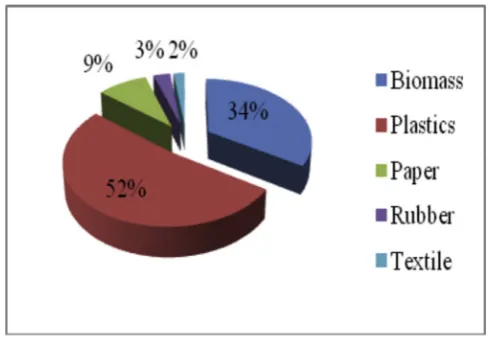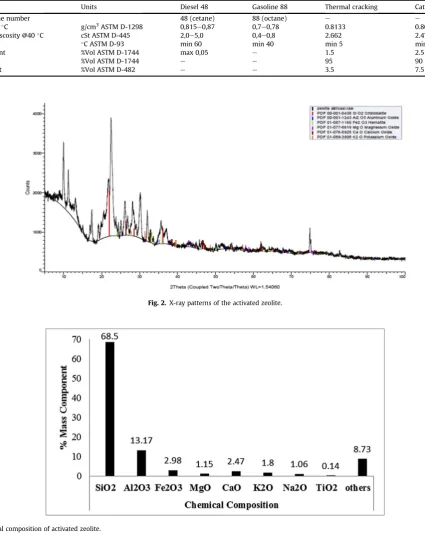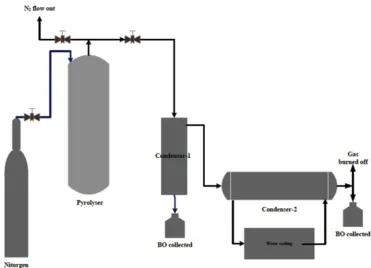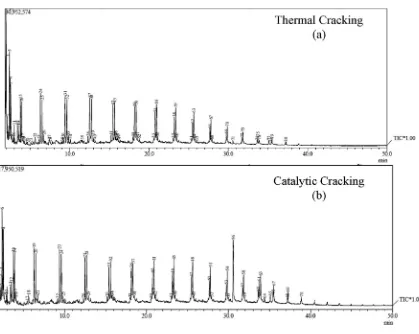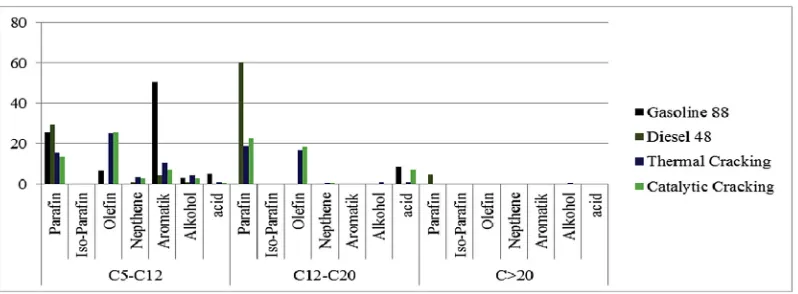Thermal
e
Catalytic cracking of real MSW into Bio-Crude Oil
Indra Mamad Gandidi
a,*, M. Dyan Susila
a, Ali Mustofa
a, Nugroho Agung Pambudi
b,c aDepartment of Mechanical Engineering, Faculty of Engineering, Lampung University, Jl. S. Brojonegoro No. 1, Bandarlampung, IndonesiabMechanical Engineering Education, Universitas Negeri Sebelas Maret, Jl. Ir. Sutami 36A, Surakarta 57126, Indonesia
cInternational Institute for Carbon-Neutral Energy Research (WPI-I2CNER), Kyushu University, 744 Motooka, Nishi-ku, Fukuoka 819-0395, Japan
a r t i c l e
i n f o
The thermal decomposition method has been able to convert of real municipal solid waste (MSW) into Bio-Crude Oil (BCO) which is mainly contained hydrocarbon fuel such as light oil (gasoline) and heavy oil (diesel). By this method, sustainable MSW management and energy problem can be considered. Hence, this research was conducted the pyrolysis experimental to BCO production from the real MSW under thermal and catalytic pyrolysis at 400C and 60 min for time reaction. To increase the BCO yield in
this study, the natural activated zeolite as a catalyst was employed. BCO was analyzed by Gas chromatographyemass spectrometry (GCeMS) which it can be used to identify carbon number range by percentage of peak areas. It was found that the catalytic pyrolysis has performances better than the thermal pyrolysis. Both of thermal and catalytic pyrolysis were the produce of BCO around 15.2 wt % and 21.4 wt% respectively with the main organic components are gasoline and diesel. Furthermore, paraffin and olefin fraction are major species in the gasoline and diesel. It can be concluded that the content of MSW and their processes has an impact on the fuel produced. In the thermal cracking produce BCO with higher content in the gasoline range. More plastic in MSW is also produce more gasoline while more biomass produces more in diesel range.
©2016 Energy Institute. Published by Elsevier Ltd. All rights reserved.
1. Introduction
Cities around the world are producing more and more municipal solid waste (MSW) due to economic growth, increasing human populations, the rise of consumerist lifestyles and continued urbanization. Many developing countries, including Indonesia, manage MSW through an open dumping system in which the MSW is disposed of in a way that leaves it exposed to the elements[1], posing health and environmental risks. Piles of trash in open landfills provide a habitat for bacteria and insects as well as pollution surrounding air, land and water[2]. The costs of transportation, maintenance and labor for improved MSW management are very high and population growth has reduced the availability of landfill space in cities. However, as a material MSW stores energy in the form of chemical bonds between molecules of carbon, hydrogen and oxygen[3]. When these chemical bonds are destroyed, the organic material reacts and converts into gas, liquids or solids that are commonly called bio-fuel[4]. The calorific value that can be generated from most MSW is around 20.57/kg[5]. Thus, MSW is a raw material with considerable potential to be converted into bio-energy. Several methods for bio-energy production from MSW have been proposed, one of which is the pyrolysis method.
The pyrolysis method is a thermal degradation in which MSW is converted into solids, liquids and gasses at an elevated temperature without the presence of oxygen[6]. Usually, the temperature ranges from 400 to 600C. This process is intended to break down long
hydrocarbon chains into short-chain hydrocarbons. MSW appears eligible as a raw material for Bio-Crude Oil (BCO) production through pyrolysis[7e10]. However, the pyrolysis process has low efficiency regarding the endothermic reaction at high temperatures. Fortunately, the addition of a catalyst in the process can overcome these problems, as the presence of the catalyst reduces the activation energy and improves the decomposition reaction and product yield. Chika M et al.[11]carried out pyrolysis using Y-zeolite and ZSM-5 as catalysts to convert electric and electronic plastic waste into BCO; Aida et al.[12]usedfluidized catalytic cracking (FCC) to convert plastic waste; Norbert
*Corresponding author.
M et al.[13]performed catalytic pyrolysis with Y-zeolite, FCC, MoO3and HZSM-5 to convert MSW and municipal plastic waste (MPW); JL Wang et al.[14]studied the effect of a Si/Al ratio on the BCO yield; Funda A et al.[15]studied efficiency of several catalysts (Y-zeolite,
b-zeolite, equilibrium FCC, MoO3, NieMo-catalyst, HZSM-5) on the catalytic cracking of MSW and MPW. However, all of the researchers above have used synthetic or commercial catalysts in the pyrolysis process, which increase the costs of production, and these catalysts have a faster deactivation time because of MSW impurities and contaminants.One of the best solutions to reduce these costs is to use natural catalysts that are abundant in the environment. A number of researchers have investigated thermal catalytic degradation using natural catalysts. Wenger Jorn[16]performed catalytic pyrolysis to produce BCO from mixed plastic waste using clay as catalyst; Kyaw K T et al.[17]carried out a pyrolysis experiment to make a comparison between clay and dolomite as catalysts; Panda KA et al.[18]used kaolin in the polypropylene pyrolysis and Mochamad S et al.[19]carried out two stage pyrolysis of HDPE and PP as raw material with natural zeolite to produce BCO.
Nevertheless, most of the papers cited above performed single-component pyrolysis or used MSW that was specified such as pure and mixed plastic material for BCO production. Meanwhile, the MSW in developing countries generally includes a huge variety of mixed waste and it is impossible to collected different kinds separately because of the large quantities produced. Also, more information about the BCO characteristics of real MSW (unseparated) in pyrolysis is necessary before it can be used as an engine fuel. Moreover, so far zeolite has not been used as catalyst in the real MSW pyrolysis process.
Therefore, this research was focused on BCO production from real MSW by the pyrolysis method, in which it is a mixture of some kinds of biomass waste, several plastics waste, textile waste, papers waste and rubber waste. The pyrolysis experiment was performed under cat-alytic pyrolysis. Pyrolysis BCO further was analyzed to study the characteristics such as product composition and yield, as well as chemical and physical properties. Afterward, a comparison between the results of pyrolysis and conventional oil (diesel-48 and gasoline-88) was performed to examine the possibility of using MSW as a substitute for conventional fuels.
2. Material and methods
2.1. Waste and catalyst for pyrolysis
The 25 kg of real MSW sample that used in this experiment was collected from afinal disposal site in Bakung district, Bandarlampung, Indonesia. This sample consisted of various kinds of waste, including vegetable waste from the traditional market, garden and household wastes, LDPE, HDPE, paper/cardboard, PS, rubber waste and textile waste. The real MSW sample was then dried by the sun for around 3e5 days. After drying process, the MSW sample separated to account for its composition before it was chopped into smaller pieces around 5e10 cm to provide the appropriate size for reactor capacity. The composition (dry basis) and physical form of the MSW is shown inFig. 1. Just over half of the MSW consisted of plastic waste such as bottles and plastic bags. Another third was made up of biomass, including vegetable, garden and kitchen waste. Almost a tenth consisted of discarded paper, newspapers and cardboard, 3% was rubber waste, and 2% of the MSW came from textiles.
The natural zeolite used in this study was a material from a local source in Lampung province that donated by CV. Mina Tama, Ban-darlampung, Indonesia as a trader of natural zeolite. Based on their data, the natural catalyst is the clinoptilolite type crystalline matter and the chemical composition of natural zeolite are majority consisted of silicon dioxide or silica (68.5%). It also contained 13.17% aluminum oxide, 2.98% ferric oxide, 2.15% magnesium oxide, 2.47% calcium oxide (quicklime), 1.8% potassium oxide, 1.06% sodium oxide, 0.14% titanium dioxide, and the remaining others (seeFig. 3). To examine the structure of natural zeolite activated, the XRD analysis was employed and the XRD patterns of the activated natural zeolite is shownFig. 2. It can be seen that the activated zeolite has a good crystallinity behavior (characteristic peaks sharply). That is indicated stable at high temperatures and appears likely to produce a strong effect in the decom-position of real MSW.
2.2. Pyrolysis experiment
The real MSW sample was pyrolysed in a laboratory scale usingfixed bed vacuum reactor (pyrolyser) as shown inFig. 4. It equipped with secondary reactor as a hopper which is placed at the top of the pyrolyser. It was then connected by a tunnel that equipped by air lock valve.
The pyrolyser was made from the stainless cylinder with the dimensions of 310 mm in height, 160 mm in diameter, and the electrical heating jacket was taped around it, whereas the hopper was made from the cast iron cylinder with the dimensions of 250 and 160 mm in height and diameter respectively. The pyrolyser and hopper were set vertically.
In this experiment,firstly the MSW sample (similar with the real MSW composition) was placed into the hopper, while the pyrolyser was heated at a rate of 12C until its temperature reached the set value of 400C. Afterward, from the top of pyrolyser, N2 gas was introduced for
3 min, and thenflowed out again through the top of the pyrolyser. Aflow of nitrogen will push down and replaced the air from the pyrolyser and permitted the pyrolysis reaction under inert vacuum conditions. Then, samples of MSW were fed into the pyrolyser by opened up the air lock valve: 500 g of real MSW sample for non-catalytic pyrolysis and 750 g of mixed catalyst-MSW. The ratio of catalyst to MWS was 250:500 g. For both pyrolysis experiments, the reaction time was held for 60 min.
Table 1 Properties of BCO.
Properties Units Diesel 48 Gasoline 88 Thermal cracking Catalytic cracking
Cetane octane number 48 (cetane) 88 (octane) e e
Density @15C g/cm3ASTM D-1298 0,815e0,87 0,7e0,78 0.8133 0.8076
Kinematic viscosity @40C cSt ASTM D-445 2,0e5,0 0,4e0,8 2.662 2.4775
Flash point C ASTM D-93 min 60 min 40 min 5 min 5
Water content %Vol ASTM D-1744 max 0,05 e 1.5 2.5
Oil content %Vol ASTM D-1744 e e 95 90
Solid content %Vol ASTM D-482 e e 3.5 7.5
Fig. 2.X-ray patterns of the activated zeolite.
The gas produced during pyrolysisflowed out from the top of the reactor and into a vacuum gas cleaner, which served as afirst condenser. Next, the gas went into the shell and tube condensers, which served as secondary condensers to separate liquid from the gas. The temperature of the gas in the shell and tube condensers was maintained at 20C by water pump circulation. The condensation product from
the vacuum gas cleaner and the condensers was made up of a mixture of water and bio-oil, which were separated by a series of precipitation andfiltration processes. The clean BCO was then weighed. The gaseous products were burned off to prevent the emission of hydrocarbon gasses. The char produced by heating MSW in the reactor remained at the reactor bottom and was collected and removed after the pyrolysis reaction was completed. Finally, four replicates were performed for both of pyrolysis experiment.
2.3. BCO analysis
The products obtained from the pyrolysis can be divided into non-condensable gas, solid and liquid (BCO) fractions. From the BCO yield, hydrocarbon chains in the gasoline range (C5eC12), diesel (C12eC20) and heavy oils (>C20) that consist of paraffin, olefins, naphthenes and aromatics[20]can be recovered. In order to examine the BCO, the pyrolysis liquid was analyzed using a gas chromatography mass spec-trometry (GCeMS, QP2010S Shimadzu) which can identify carbon number range and chemical composition by percentage of peak areas. The column was a DB-1 (Agilent J 100% dimethyl polysiloxane) capillary column, 30 mm length with 0.25 mm diameter and 25
mm
film thickness. Helium was used as the gas carrier. The temperature was initially set at 60C for 5 min, followed by a heating rate of 5C/min to280C, where it was held for 51 min. The heating value was estimated using the carbon-hydrogen weigh ratio[21], according to which the
paraffin has highest heating value, followed by iso-paraffin, olefin, naphthenes and aromatic (PIONA).
3. Results and discussion
3.1. Physical properties
The physical properties of BCO and conventional oil, including viscosity, density and content, were analyzed based on ASTM methods. The results are shown inTable 1. It can been seen that BCO has physical properties close to those of diesel-48 oil, although solid and water content was high in the BCO due to impurities in the unwashed real MSW and direct catalyst. In BCO derived from both thermal and catalytic cracking, the presence of activated zeolite in the pyrolysis process was adequate to improve the density and viscosity properties.
3.2. Chemical properties
The output of GCeMS analysis is a GC graph and MS tabulation. The entire of peak on GC graph was represent the amount of hydrocarbon chain in the BCO and MS tabulation was used to calculate the percent peak area of each chemical composition peak by Wiley's Library assist. The chromatogram results for thermal and catalytic cracking analyzed by GCeMS are shown inFigs. 4b and 5a. A real difference can be seen on the peaks of both chromatograms as a representation of chemical composition such as carbon distribution and mass species content in the pyrolytic BCO.
The product from the real MSW in pyrolysis is shown inFig. 6. Thermal cracking produced 15.2 wt% BCO and catalytic cracking produced 21.4 wt% BCO. The presence of activated zeolite in the pyrolysis process evidently improved the secondary cracking into small hydrocarbon chains, and this obtained a remarkable increase of BCO yield by around 40.79% compared without catalyst. This means that zeolite has an excellent productivity behavior as a catalyst in the pyrolysis process.
This behavior can be explained due to its active sites and acidity, which facilitate the cracking reaction in pyrolysis. However, the higher yield of gaseous product and appearance of water content in the BCO imply that the real MSW required further drying, and the temperature of the condensation environment, around 20C, was unfavorable. Moreover, the low BCO yield can also be associated with the short reaction
time and long residence time of gas in the reactor[22]and also caused by biomass material presence that tends to produce of gaseous product[19], or plastic waste will lead to increase the yield of pyrolytic BCO[23].
The influence of activated zeolite on the carbon range and mass species in BCO is shown inFigs. 7 and 8. Meanwhile, PIONA percentage results in each hydrocarbon range are presented inFig. 8. The PIONA results can represent the high heating value in the Bio-Crude Oil during pyrolysis.
Fig. 5.Chromatogram of the BCO mass fraction.
Fig. 7shows that the BCO produced from the pyrolysis of real MSW contains mostly gasoline (C5eC12) and then diesel (C13eC20) and heavy oil (C>20). The high amount of plastic waste in the real MSW played important role in producing the high value of gasoline range in
the BCO due to the chemical composition of plastic[24]. Regarding the short reaction time and long residence time of gas in the reactor (during slow pyrolysis), the presence of biomass in the real MSW will tended to produce of gaseous gas. Thermal cracking produced a gasoline product higher than the catalytic cracking process. This could be described as a result of secondary cracking on turning the small amount of gasoline into syngas, diesel into gasoline and solids into diesel due to the presence of a catalyst.
Moreover, based on chemical compounds in the pyrolytic BCO, paraffin, olefin, and aromatics are dominant element in BCO followed by small amount of alcohol and acids. There is only a slight difference between the amount of paraffin and olefin produced in thermal and catalytic cracking. This illustrates that the zeolite at 400C over 60 min (with the slow pyrolysis condition) has low selectivity properties. Fig. 9describes the PIONA contents in the each hydrocarbon range within the pyrolysis BCO. It shows that the gasoline fraction contained more olefin than paraffin and otherwise with the diesel fraction for both results of BCO from pyrolysis. This composition was significantly affected by kind of real MSW used in the process, especially the amount of plastics and biomass which strongly determined the kinds of chemical reactions during the pyrolysis process. The presence of impurities in the real MSW also appeared to play an important role impacting the BCO composition[25].
Fig. 7.Carbon distribution range on conventional and pyrolysis fuel.
Fig. 8.A comparison of mass species between BCO and conventional fuel.
4. Conclusion
Real MSW has great potential as a raw material to be converted into the hydrocarbon range, including paraffin and olefin using pyrolysis method. In this paper, we employ the catalytic and thermal pyrolysis method. The novelty of this paper is the MSW used that in unseparated condition since most of this waste in developing countries generally includes a huge variety of mixed waste and it is impossible to collect different kinds separately because of the large quantities produced. Natural Activated Zeolite was used as a catalyst to improve the pro-duction of bio-oil. In the experimental preparation, well-dried MSW is prepared to prevent a high water product in the yield. BCO furthermore analyzed by Gas chromatographyemass spectrometry (GCeMS) which it can be used to identify carbon number range by percentage of peak areas.
It was found that the catalytic pyrolysis has performances better than the thermal pyrolysis. Both of thermal and catalytic pyrolysis were the produce of BCO around 15.2 wt% and 21.4 wt% respectively with the main organic components are gasoline and diesel. Furthermore, paraffin and olefin fraction are major species in the gasoline and diesel. The content of MSW and their processes also has an impact on the fuel produced. The process of thermal cracking produces BCO with higher content in the gasoline range. In the content of MWS, more plastic content produce more gasoline range. However more biomass content produces more in diesel range. In the reaction time, the short reaction may reduce BCO yield and may increase the proportion of oil in the diesel range. In our future research, the influence of reaction time, the temperature, water content and the particle size of the catalyst will be investigated.
References
[1] H. Arinal, et al., Integrated System for Municipal Solid Waste Management in Bandarlampung City as an Environmental Conservation and Energy Production, Final report of strategic research grant, University of Lampung, 2010.
[2] L.C. Alexandra, Municipal Solid Waste: Turning a Problem into ResourceeWaste: The Challenges Facing Developing Countries, Urban Specialist, World Bank, 2012, pp. 2e4. [3] A. Ebru, et al., Energy content estimation of municipal solid waste by multiple regression analysis, in: 5th International Advanced Technologies Symposium, Karabuk,
Turkey, 2009.
[4] P. Mc Kendry, Energy production from biomass (part 1): overview of biomass, Bioresour. Technol. 83 (2002) 37e46. [5] D.P. Ari, et al., Feasibility Study of MSW Power Plant in Bandung, Final Report, Research Institution on ITB, 2007.
[6] A.K. Hossain, et al., Pyrolysis liquids and gases as alternative fuels in internal combustion engines: a review, Renew. Sustain. Energy Rev. 21 (2010) 165e189. [7] Y.Q. Liu, et al., Characterization of pyrolysis oil from municipal solid waste, CRETE, in: 3rd International Conference on Industrial and Hazardous Waste Management, 2012. [8] S.K. Seung, et al., Non-isothermal pyrolysis of the mixtures of waste automobile lubricating oil and polystyrene in a stirred batch reactor, Renew. Energy 54 (2013) 241e247. [9] I. Velghe, et al., Study of the pyrolysis of municipal solid waste for the production of valuable products, J. Anal. Appl. Pyrolysis 92 (2011) 366e375.
[10] D. Ayhan, Pyrolysis of municipal plastic wastes for recovery of gasoline-range hydrocarbon, J. Anal. Appl. Pyrolysis 72 (2004) 97e102.
[11] M. Chika, et al., Catalytic Pyrolysis of Waste Plastic from Electrical and Electronic Equipment, Energy Research Institute, Faculty of Engineering, University of Leeds, Leeds, LS2 9JT, UK, 2015.
[12] M.I. Aida Isma, et al., Mixed plastic wastes pyrolysis in afluidized bed reactor for potential diesel production, Int. J. Environ. Sci. Dev. 6 (8) (2015) 606e609. [13] M. Norbert, et al., Comparison of waste (MSW and MPW) pyrolysis in batch reactor over different catalysts. Part II: contaminants, char and pyrolysis oil properties,
Bioresour. Technol. 144 (2013) 370e379.
[14] J. Wang, et al., Catalytic pyrolysis of municipal plastic waste to fuel with nickel-loaded silica-alumina catalysts, Energy Sources Part A Recovery Util. Environ. Eff. 33 (21) (2011) 1940e1948.
[15] A. Funda, et al., Comparision of waste (MSW and MPW) pyrolysis in batch reactor over different catalysts. Part I: product yields, gas and pyrolysis oil properties, Bioresour. Technol. 133 (2013) 443e454.
[16] Jorn Wenger, Catalytic pyrolysis of waste plastics, J. Mater. Sci. Eng. 5 (3e4) (2015) 183e185.
[17] K.T. Kyaw, et al., Effect of various catalysits on fuel oil pyrolysis process of mixed plastic wastes, Int. J. Adv. Eng. Technol. (2015).
[18] A.K. Panda, Thermo-catalytic degradation of low density polyethylene to liquid fuel over kaolin catalyst, Int. J. Environ. Waste Manag. (2014).
[19] S. Mochamad, et al., Fuel oil production from municipal plastic wastes in sequential pyrolysis and catalytic reforming reactors, Energy Procedia 47 (2014) 180e188. [20] J. Aguado, et al., Feedstock recycling of polyethylene in a two-step thermo-catalytic reaction system, J. Anal. Appl. Pyrolysis 79 (2007) 415e423.
[21] M.R. Riazi, Characterization and Properties of Petroleum,first ed., Kuwait University, 2005.
[22] D. Ayhan, et al., Pyrolysis mechanisms of biomass materials, Energy Sources Part A 31 (2009) 1186e1193.
[23] A. Dewangan, et al., Co-pyrolysis of sugarcane bagasse and low-density polyethylene: influence of plastic on pyrolysis product yield, Fuel 185 (2016) 508e516. [24] V. Kyoseva, I. Dombalov, Chemical conversion of municipal solid waste into raw materials and energy resources, J. Chem. Technol. Metall. 49 (2014) 179e184. [25] N. Borsodi, et al., Hydrocarbons obtained by pyrolysis of contaminated waste plastics, in: 45th International Petroleum Conference, Bratislava, Slovak Republic, June 13,
